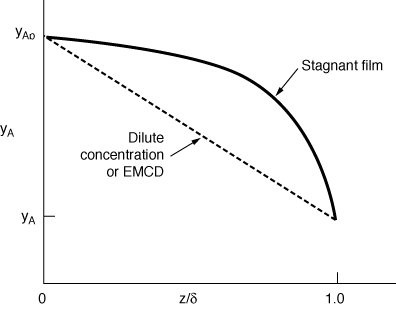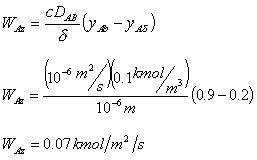Chapter 14: External Diffusion Effects on Heteregeneous Reactions
Learning Resources
Example CD14-3: Diffusion Through a Stagnant Gas
Calculate the steady-state concentration profile and diffusion
rate for the diffusion of gas A through a stagnant gas B. The geometry (Figure
E11-2.1) and boundary conditions are identical to those given in Example
11-2. The pressure and temperature, and hence the total concentration, are
constant throughout the system.SolutionSteps 1 and 2:The procedure for obtaining the differential of the molar flux with respect to distance is identical with that for the diffusion of species A through a liquid. Consequently, we can start with Equation (E11-1.3): |
||||
|
Mole balance |
|
(E11-1.3) | ||
| Step 3: We now need to relate the flux to concentration. Recalling the discussion in Section 11.2.1 and Equation (11-19), for diffusion through a stagnant film we have | ||||
|
Evaluating bulk |
|
(CDE11-3.1) | ||
| Combining Equations (CDE11-1.1) and (E11-1.3) yields | ||||
|
|
||||
| or | ||||
|
Differential |
 |
(CDE11-3.2) |
||
| Integrating, we obtain | ||||
|
|
(CDE11-3.3) (CDE11-3.4) |
|||
| Step 4: The constants of integration can be evaluated using the following boundary conditions: | ||||
|
|

|
(CDE11-3.5) (CDE11-3.6) |
||
| Step 5: Applying the first boundary condition, we obtain | ||||
|
|
(CDE11-3.7) | |||
| Using the second boundary condition yields | ||||
|
|
(CDE11-3.8) |
|||
| Combining Equations (CDE11-3.4), (CDE11-3.7), and (CDE11-3.8) gives us | ||||
|
|
(CDE11-3.9) | |||
| Rearranging yields | ||||
|
Concentration |
|
(CDE11-3.10) | ||
| The concentration profile is shown in Figure CDE11-3.1. The
concentration profiles for the case of dilute gas or EMCD are compared with
diffusion through a stagnant film in Figure CDE11-3.1. |
||||

Figure CDE11-3.1 |
||||
Step 6: To obtain the molar flux, we differentiate Equation (CDE11-3.9) with respect to  and multiply by cD AB. That is, we combine Equations (CDE11-3.9) and (E11-8.1)
to obtain
and multiply by cD AB. That is, we combine Equations (CDE11-3.9) and (E11-8.1)
to obtain |
||||
|
|
(CDE11-3.11) | |||
This problem is reworked for diffusion through a stagnant film in the solved example problems on the web solved problems |
||||
If we had assumed diffusion through a stagnant film (Wbz = 0 and BAz = YAWA) rather than dilute concentration or equal molar counter diffusion (BAz = 0), we could use the solution procedure discussed above, starting with |
||||
|
(E11-13) | |||
| to arrive at | ||||
|
(E11-14) | |||
| The intermediate steps are given on the CD-ROM. For the same parameter values as before, | ||||
|
(E11-15) | |||
| For the case of EMCD | ||||
|
||||
| Net diffusion through a stagnant film is faster. | ||||










